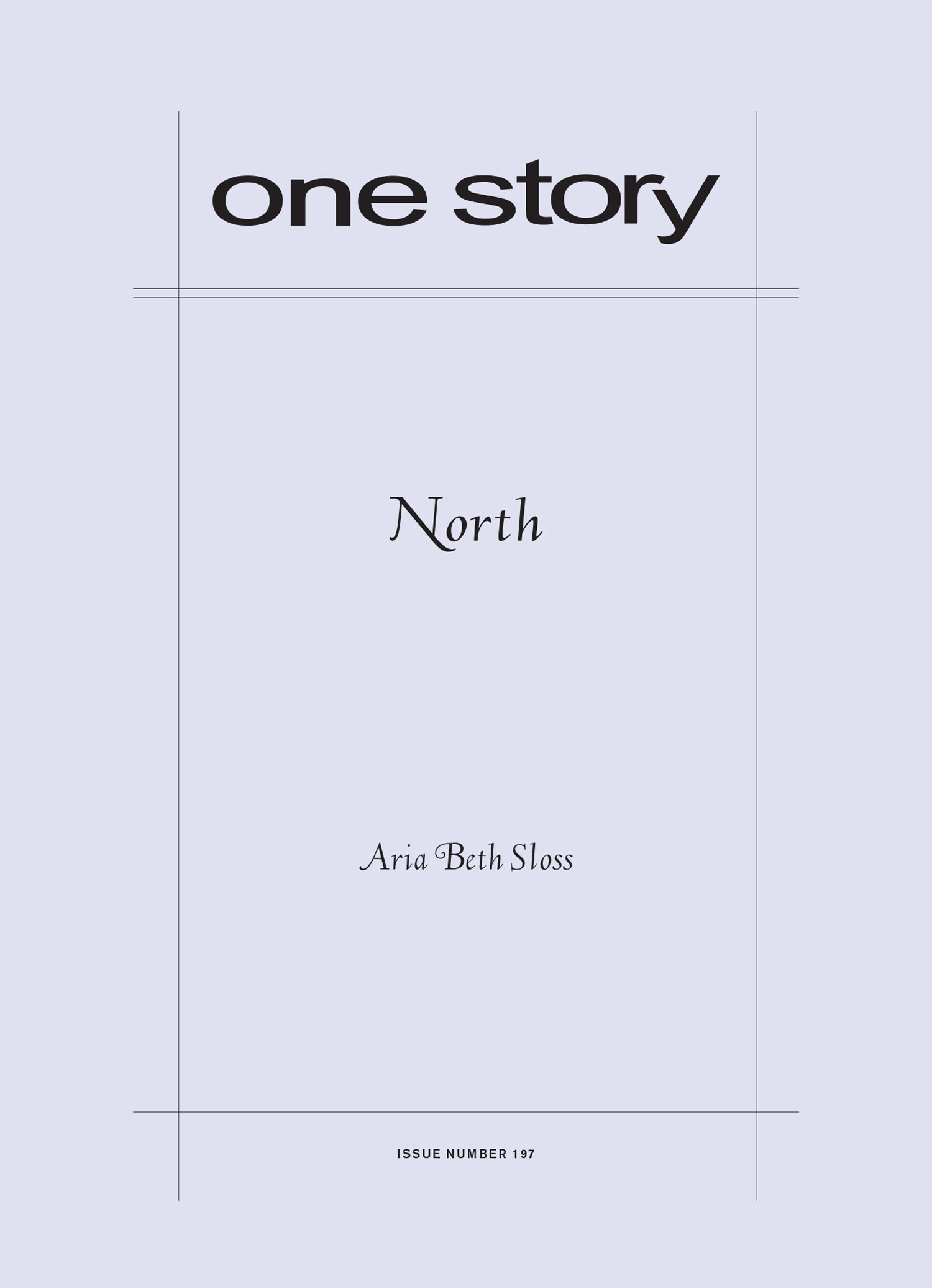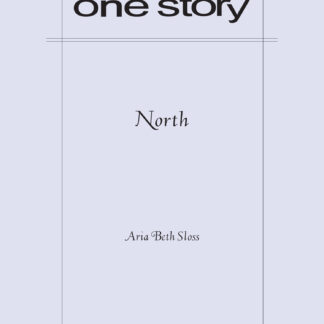
North
$2.50
66 in stock
Excerpt
My father made it as far as Little Iceland. That was the name of the iceberg they found his notebook frozen into, interred like a fossil. At least that was the name written on one of the last pages of his notebook, under a sketch of what might or might not have been the iceberg. There was the question, in those days, of what to name. The impulse was to lay claim to each new fragment of the unknown. Label everything. But icebergs do as they please. They form and break so quickly, it is possible to claim one one day only to watch it divide itself out of existence the next.
What my mother said: we do what we can to make things stick.
Aria Beth Sloss
Aria Beth Sloss is the author of Autobiography of Us, a novel. She lives in New York City.
Karen Friedman on “North”
Ambition can be a tricky thing. Not enough and you wind up living in your mom’s basement. Too much and, well, you just might be a megalomaniac. How far can you dream and what would you give up to attain that dream? Despite all our technology and prosperity, for most of us, our aspirations can seem small. However, the late nineteenth century was full of men and women whose ambition was intertwined with a sense of entitlement and desire for adventure. Men, like Thomas Hamblen in our latest issue, “North” by Aria Beth Sloss, who pushed the boundaries of what was known by sheer force of will. In the story, Thomas believes he can reach the North Pole by hot air balloon. The idea takes hold and obsesses him, even as it places his sanity and much that he holds dear at risk. But “North” is not merely the story of an adventurer, it is also a love story, and Thomas’s wife, Mary, is fearless in her own right. Through their relationship we parse the distinction between wilderness and what is known, and the cost of un-tempered desire. Every time I read “North,” I’m struck by how much faith Thomas has in science and his own ability to conquer whatever challenges he encounters. Today, when doubt and sometimes a downright hostility toward science seem to be the norm, how glorious Thomas’s sense of possibility feels. I hope you will all love “North” as much as we do at One Story. After you read it, please be sure to check out our Q&A with Aria, and look here if you are interested in seeing some amazing photographs of the expedition that first inspired her.
Q&A by Karen Friedman
- KF: Where did the idea for this story come from?
- AS: My daughter (our first child) arrived about two weeks after my first novel, AUTOBIOGRAPHY OF US. It was February, and my memory of that month is one of delirious housebound exhaustion. But the secret about newborns is that they sleep most of the day, and I probably read more those first weeks than I’ve read since. One of the books I stumbled across was Alec Wilkinson’s fantastic THE ICE BALLOON, the story of S.A. Andrée, a Swedish engineer who tried to fly a hot-air balloon to the North Pole right before the turn of the 19th century. I finished it around the time my husband—a chef who owns two restaurants and works brutal hours—had to go back to work. You can hear the writerly machinery whirring, can’t you? Balloon, Arctic exploration, motherhood, abandonment, snow...I suppose the story was my way of taking all the details of my strange new life and blowing them up to the extreme so I could examine them from different angles, like evidence at a crime scene. Which is, I’m afraid, how I write everything.
- KF: Mary’s understanding of what wilderness and ambition mean changes during the course of the story. Without giving away too much, can you talk a bit about the way you juxtapose Mary and Thomas and if that dynamic was there from the start?
- AS: Giving birth is the wildest experience I’ve ever lived through—followed closely by everything that comes after—so yes, right from the beginning, I was working from a place of understanding motherhood as vast and uncharted territory. But I started the story thinking it was about Thomas and this explosion of Arctic exploration that occurred in the mid-to-late 19th century; it wasn’t until I’d written the bulk of the first draft that I realized what I was really trying to explore was the dichotomy of male and female ambition—both how men and women understand and conceive of ambition, as well as how society expects them to act on those ambitions. The specter of motherhood is always out there; choosing not to become a mother is still a far more shocking choice than choosing not to become a father, and the biology of reproduction still, last time I checked, demands that a woman carry a child, give birth to it, and, in many cases, feed it from her body. These are not simple matters. They are also not without enormous significance. The truth is that I was shocked to realize how radically motherhood altered me—my daily life, my priorities, my sense of what it means to be a human body on this earth. I liked the idea of being able to look at that shock through a character whose choices would have been far more limited than mine, but who also might have felt so many of the strange, conflicting emotions I felt both in the anticipation of motherhood as well as the aftermath.
- KF: “North” is told by Thomas and Mary’s daughter, a character who is not yet alive during the bulk of the time that the story covers. And yet, we’re in present tense. Where did the voice come from and why did you want to tell the story from that vantage?
- AS: Honestly, I think I’m just one of those writers who keeps circling the same set of small mysteries, trying to untangle various threads. One of my threads is family, particularly the dynamic between parents and children. There’s a line near the beginning about Thomas’s story being a puzzle waiting to be solved; that is, I think, how every child comes to think of his or her parents. It also happens to be the way I think about stories, or novels, whatever I happen to be working on. There’s always something that has to be unlocked. But again, I’m an admittedly self-interested writer. I wrote this story because having a child shattered any illusions I’d had that I understood what I was doing in the world, and the voice of this narrator, to my mind, is the voice of a woman trying to tap into some central line of longing in her life, trying to trace things to their source. I needed both distance as well as intimacy with Thomas and Mary, and with their relationship: who else could have that but a child?
- KF: What was the most challenging aspect of writing this story?
- AS: I definitely struggled with the tension between historical truth and narrative truth—two separate and equally demanding mistresses. I never would have come up with the idea of someone attempting to reach the North Pole by balloon on my own, so I owe an enormous debt to Alec Wilkinson, to his fabulous book, and to the ill-fated Andrée. But I always find it difficult to transition from the seed of a story—that nugget of trivia, the thing your uncle said at Thanksgiving, the image of a balloon rising into the sky—to what, as I write through different drafts, reveals itself as the story’s true concern. With “North,” once I unhooked myself from the allure of the historical story, I found my own story’s freakish beauty, which was another thing entirely.
- KF: You and I have spoken a bit about your research for this story, and the way you can spend hours down that rabbit hole, even if it’s only tangential to what you actually need. What was your favorite find while researching?
- AS: Oh my god, how much space do I get? I feverishly Googled and linked my way onto some incredible websites, like the one featuring cartoons about the French war balloons that brought mail and food back and forth into Paris during the German-French War. Or the one selling a beautiful print showing a Montgolfier hot-air balloon that took off from Versailles, carrying a rooster, a sheep, and a duck. But my favorite may be the one I sent you, about the Great Balloon Riot of 1864. A car set on fire, a mob of disappointed balloon fans, and, after, a new name for the town residents—“Balloonatics”. Clearly, there is much, much more to be written about balloons.
- KF: How long did it take you to complete this story?
- AS: This was probably the quickest turnaround from start to finish I’ve ever experienced. I wrote a draft in about two weeks, put it away, worked on it for about two weeks with my agent, and then hemmed and hawed over it with you for another two weeks. So really, a month and a half of actual work. This will never, ever happen again.
- KF: What are you working on now?
- AS: I’m smack in the middle of unsnarling various plot strands in a novel about a musical prodigy (see? Family, parents, child, REPEAT). I’d like to say the title here because I feel in my gut of guts it’s the right one, and it’s about all that’s right with it these days: LITTLE MONSTER.
- KF: What is the best bit of advice about writing you have ever received?
- AS: My first teacher at Iowa was the marvelous Margot Livesey, and at our first meeting, as we were puzzling over something or other in my story, trying to parse out the many different angles I could try, she finally looked at me and said in her wonderful Scottish burr: “Or, you know, sometimes you just have to write it better.” I’ve always loved that. Yes, you can change the point of view, or switch around a few paragraphs, or rethink a character, and yes, occasionally that really will do the trick. But sometimes, dammit, you just have to write it better.
